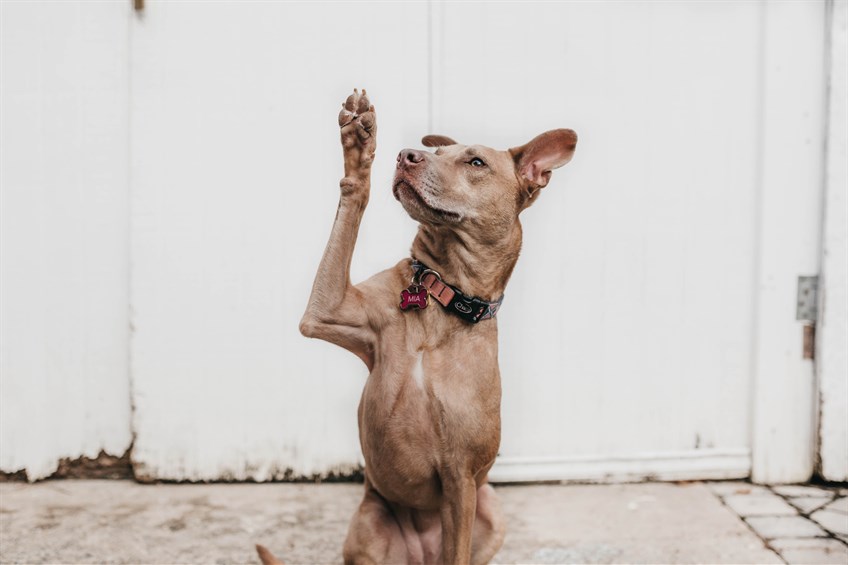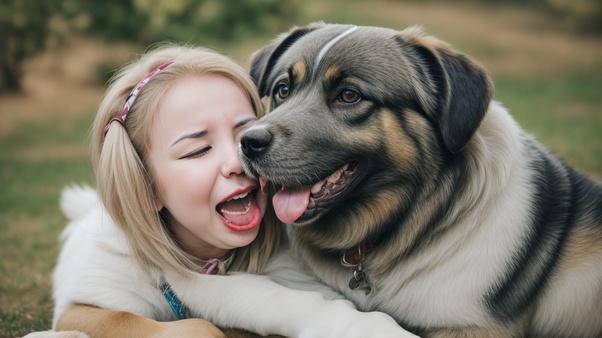Why does my dog lick my other dog’s face? Dogs lick each other’s faces as a way to show friendliness, affection, or deference.
It’s a natural behavior that is similar to humans kissing or hugging. The act of licking releases endorphins, making both dogs feel more relaxed and happier. However, if the licking becomes obsessive or excessive, it may be a sign of an underlying health condition or anxiety.
In most cases, though, it’s a harmless behavior that promotes social bonding and communication between dogs.

Credit: www.amazon.com
Understanding Canine Licking Behavior
When a dog licks another dog’s face, it is a sign of friendliness, affection, or deference. Similar to humans kissing and hugging, licking releases endorphins that make both dogs feel more relaxed and happy.
The Purpose Of Canine Licking
Dogs have a natural instinct to lick, and they often use licking as a form of communication with other dogs in their pack or social group. While it may seem strange to us humans, licking is an important part of their social behavior and serves various purposes.
One of the main reasons why dogs lick each other’s faces is to show friendliness, affection, or deference. It’s their way of saying, “I am part of your pack” or “I respect you as a higher-ranking member.”
Licking also releases endorphins in both the licker and the recipient, which can create a sense of relaxation and happiness. This bonding behavior mimics the human act of kissing and hugging, strengthening the emotional connection between dogs.
Additionally, licking can serve a grooming function. Dogs lick each other to help keep their coats clean and free from dirt or debris. They may also lick sensitive areas like the ears to remove potential irritants or pests like ear mites.
Licking As Communication
Licking plays a crucial role in canine communication. Dogs use their tongues to convey a range of information to other dogs or their human companions. For example, a dog licking another dog’s face can be a sign of submission, recognizing the other dog’s higher social standing.
On the other hand, if a dog licks your face, it can be a gesture of affection, respect, or a way of seeking attention. Licking can also be a way for dogs to show submission to their human pack members.
It’s important to note that excessively licking can indicate anxiety, stress, or discomfort in dogs. If you notice your dog licking excessively or obsessively, it’s advisable to consult with a veterinarian to rule out any underlying medical issues or behavioral problems.
The Role Of Licking In Canine Relationships
Licking plays a significant role in building and maintaining relationships among dogs. It helps establish social bonds and reinforces the hierarchy within a pack. Dogs use licking as a form of communication to express emotions, build trust, and maintain harmony within their social group.
In multi-dog households, especially those where dogs have a close bond with each other, face licking is a common behavior. It can be seen as a way of reinforcing their connection, showing acceptance, and promoting a sense of unity within the pack.
Overall, understanding why dogs lick each other’s faces is essential for interpreting their behavior accurately. While it may seem unusual to us, it is a natural and crucial part of canine social interaction.
Credit: www.quora.com
Exploring Face Licking
Dogs lick each other’s faces as a way to show love and strengthen their bond, similar to how humans kiss and hug. The act of licking releases endorphins, making both dogs feel more relaxed and happier.
Face licking is a common behavior among dogs, and understanding why they do it can provide valuable insight into their social dynamics and emotions. In this article, we will delve into the reasons behind face licking, including its role as a sign of affection, its connection to social hierarchy, and potential issues that may arise from this behavior.
Face Licking As A Sign Of Affection
Face licking is often seen as a display of love and affection from one dog to another. Similar to how humans express affection through hugging or kissing, dogs use licking to communicate their feelings. When a dog licks another dog’s face, it releases endorphins that create a sense of relaxation and happiness for both parties involved.
This behavior is particularly common among dogs within the same family or pack who share a strong bond. It is a way for them to strengthen their social connection and show their love for each other. If your dog licks your other dog’s face, it is a good sign that they are in a harmonious relationship and feel comfortable with each other.
Social Hierarchy And Face Licking
Aside from affection, face licking can also be linked to social hierarchy within a pack. When dogs recognize another dog as having a higher rank, they may express submission by licking the other dog’s mouth. This behavior is reminiscent of how young dogs interact with their parents and is a way for them to show respect.
However, it is essential to note that face licking in this context should be mutual and voluntary, with both dogs accepting and engaging in the behavior. Forced or uninvited licking may indicate a dominant behavior, especially if the dog starts showing other signs of dominance such as disobedience or demanding behavior.
Potential Issues With Face Licking
While face licking can be a harmless expression of love and respect, there are a few potential issues that dog owners should be aware of. Excessive licking can lead to irritation or even an infection, especially when it comes to sensitive areas like the eyes and ears. It is crucial to monitor your dogs’ licking habits and seek veterinary attention if you notice any signs of discomfort or redness.
Additionally, face licking can sometimes extend beyond the bounds of the canine world and include humans. While some pet owners may find this behavior endearing, it is essential to establish boundaries and train your dog not to lick people’s faces if it makes you or others uncomfortable.
In conclusion, face licking serves as a fascinating insight into the social dynamics and emotions of dogs. It can be a sign of affection, a way to establish a social hierarchy, or indicate potential issues that need attention. Understanding the reasons behind this behavior can help foster healthier relationships between dogs and their owners.
Managing And Training Licking Behavior
When it comes to dogs licking each other’s faces, it can be a behavior that is either endearing or concerning for pet owners. While licking can be a sign of affection or submission, excessive or unwanted licking can become a problem. As responsible dog owners, it is important to manage and train your dogs’ licking behavior to ensure harmony and a healthy relationship between them. Here are some effective strategies to redirect licking behavior, establish boundaries, and seek professional help if necessary.
Redirecting Licking Behavior
If you notice that your dogs are engaging in excessive or unwanted face licking, it is crucial to redirect their attention to more appropriate behaviors. By providing them with alternative activities, you can distract them and discourage the licking behavior. Here are a few tips:
- Offer interactive toys or chew bones to keep their mouths occupied.
- Engage them in interactive play sessions to redirect their energy.
- Provide mental stimulation through puzzle toys or training exercises.
By redirecting their focus, you can help them develop healthier habits and reduce the excessive licking.
Establishing Boundaries
Dogs thrive on clear boundaries and guidelines. It is essential to establish rules regarding licking behavior to ensure a balanced and respectful relationship between your dogs. Here are some strategies to establish boundaries:
- Consistently reinforce the “No licking” command when it is not appropriate.
- Use positive reinforcement techniques, such as treats or praise, when your dogs refrain from licking.
- Avoid reinforcing licking behavior by not reacting or rewarding them when they lick excessively.
- Set aside designated times for social interactions where licking is allowed, such as during supervised play sessions.
By setting clear boundaries and reinforcing positive behaviors, you can establish a healthier dynamic between your dogs.
Seeking Professional Help
If you have tried redirecting their licking behavior and establishing boundaries with no success, it may be time to seek professional help. Consulting with a certified dog trainer or a veterinary behaviorist can provide valuable insights and guidance. They can assess the underlying reasons for the excessive licking and tailor a training plan specific to your dogs’ needs. Remember, professional help can make a significant difference in managing and modifying unwanted licking behavior.
In conclusion, while dogs’ face licking can be a gesture of love, it is important to manage and train this behavior to ensure a harmonious relationship between them. By redirecting the behavior, establishing boundaries, and seeking professional help if needed, you can create a balanced and healthy environment for your furry friends.

Credit: canagan.com
Frequently Asked Questions Of Why Does My Dog Lick My Other Dog’s Face
Why Does My Dog Obsessively Lick My Other Dogs Face?
Dogs lick each other’s faces to show love and bond, similar to humans kissing and hugging. Licking releases endorphins, making both dogs feel more relaxed and happy.
Why Does My Dog Lick My Other Dog’s Mouth?
Dogs lick other dogs’ mouths to show affection and respect, similar to humans kissing and hugging. It releases endorphins, making both dogs feel relaxed and happy.
Why Does My Dog Lick My Other Dogs Eyes And Ears?
Dogs lick each other’s eyes and ears to show love and bond with their furry friends. Licking releases endorphins, making both dogs feel relaxed and happy. It can also help ward off ear mites, but too much licking can cause irritation and possible infection.
Do Dogs Lick To Show Dominance?
Dogs may lick to show dominance, especially when the licks are uninvited and accompanied by dominant behaviors. This can include not obeying commands and acting in a demanding way.
Conclusion
When your dog licks your other dog’s face, it’s a display of love, bonding, and respect. Similar to human kisses and hugs, licking releases feel-good endorphins that create a sense of relaxation and happiness for both dogs. However, excessive licking can lead to irritation or potential ear infections, so it is important to monitor their behavior.
Overall, dog-on-dog face licking is a harmless and positive behavior that signifies their friendly nature and intent.



